Khao Yai National Park
Khao Yai National Park (Thai: อุทยานแห่งชาติเขาใหญ่, RTGS: Utthayan Haeng Chat Khao Yai, pronounced [ʔùt.tʰā.jāːn hɛ̀ŋ t͡ɕʰâːt kʰǎw jàj]) is a national park in Thailand.
| Khao Yai National Park | |
|---|---|
IUCN category II (national park) | |
 Haew Suwat waterfall | |

| |
| Location | Nakhon Ratchasima, Thailand |
| Nearest city | Pak Chong District |
| Coordinates | 14°26′29″N 101°22′11″E |
| Area | 2,168 km2 (837 sq mi) |
| Established | 1962 |
| Visitors | 1.2 million (in FY2016) |
| Governing body | Department of National Parks, Wildlife and Plant Conservation |

Description
Khao Yai National Park is in the western part of the Sankamphaeng Mountain Range, at the southwestern boundary of the Khorat Plateau. The highest mountain in the area of the park is 1,351 metres (4,432 ft) high Khao Rom. This park lies largely in Nakhon Ratchasima Province (Khorat), but also includes parts of Saraburi, Prachinburi, and Nakhon Nayok Provinces.
The park is the third largest in Thailand. It covers an area of 2,168 square kilometers, including tropical seasonal forests and grasslands. Elevations mostly range from 400–1,000 metres (1,300–3,300 ft). There are 3,000 species of plants, 320 species of birds like red junglefowl and coral-billed ground cuckoo, and 66 species of mammals, including Asian black bear, Indian elephant, gaur, gibbon, Indian sambar deer, southern pig-tailed macaque, Indian muntjac, Ussuri dhole, and wild pig. There are no tigers in Khao Yai, and there have not been any for at least 20 years. Its waterfalls include the 80-metre (260 ft) Heo Narok, and Heo Suwat made famous from the film The Beach.
Recent wildlife studies show that animal ranges, particularly the few resident tigers, are impacted by human activity near the center of the park.
History
Around 1922 some people from Ban Tha Dan and Ban Tha Chai villages in Nakhon Nayok Province built a settlement within the forest in the Sankamphaeng mountains. Up to 30 households cultivated the land. The area was formally recognized by the government and classified as Tambon Khao Yai within Pak Phli District.
However, due to its remoteness from the authorities it became a refuge for criminals and fugitives. After an attempt to capture the suspects in the area, in 1932 the villagers were relocated into the plains some 30 km away and the tambon status was cancelled.
In 1959 the prime minister, Field Marshal Sarit Thanarat, instructed the Ministry of Agriculture and the Ministry of the Interior to create a process whereby national parks could be established.

Khao Yai National Park was then established on 18 September 1962, declared by royal proclamation in the Government Gazette (Book 79, Section 89) as the first national park in Thailand. A major role in its establishment was played by Boonsong Lekakul, one of the 20th century's most famous Thai conservationists. It was named after the defunct tambon, Khao Yai.
In 1984 the park was made an ASEAN Heritage Park, and on 14 July 2005 the park, together with other parks in the same range and in the Dong Phaya Yen Mountains further north, was proclaimed a UNESCO World Heritage Site under the name "Dong Phaya Yen–Khao Yai Forest Complex". As the lands adjacent to the national park are becoming increasingly developed into luxury hotels and golf courses, acquiring land for future wildlife conservation efforts is becoming problematic. Homes and residential villas have been built illegally within the limits of the protected area of the forest.[1] Illegal logging is also a problem in the area of the park.[2]
Visitors
According to the Department of National Parks (DNP), which manages the park, visitors to Khao Yai have risen from 671,569 in 2008 to more than 1.2 million in FY2016. From October 2015 to September 2016, 471,514 vehicles entered the park. The congestion has led to demands to close the park to private vehicles.[3] During one of its busiest periods, New Year's week from 30 December – 3 January 2016, the park saw 156,574 visitors. They left in excess of 23 tonnes of waste behind.[4]
Climate
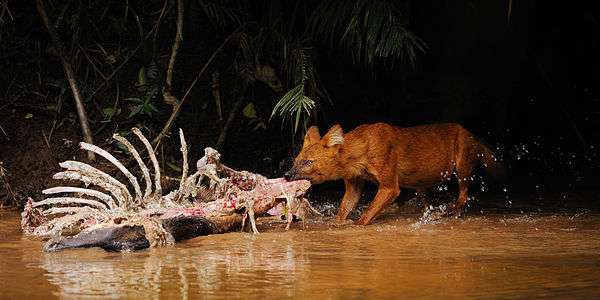
Khao Yai National Park has three main seasons, with an annual mean temperature of 23° Celsius, though this varies greatly with the seasons.
- Rainy season (May–October): Most days have high rates of precipitation. The atmosphere is humid with average temperatures of 27 °C during the day dropping to 13 °C at night. Streams at peak flow.
- Cool season (November–February): Clear skies, sunny and cool. Average temperatures of 22 °C during the day and 10 °C at night. Good time for hiking.
- Hot season (March–April): Humid with daytime temperatures of 20–30 °C and 17 °C at night.
Geology

Limestone is present towards the eastern end close to the Dângrêk Mountains. Sandstone outcrops exist in the south and north of the park. Shales and schist are also present. In the south, steep slopes made of granite and conglomerates are seen.
Drainage
There are four drainage areas in the park which are vital catchments for four river systems. The Lam Takhong River drains from the central Khao Yai area and runs in a northeasterly direction to the Mekong. The Sai Yai River system drains from the eastern basin, turning sharply into the southern floodplains and on to the Gulf of Thailand. The Nakhon Nayok River system drains from the southwest watershed into Nakhon Nayok Province to the south. The Saraburi Province drainage system drains westward from the far west of Khao Yai.
Fauna
Khao Yai is home to a variety of animals. It is one of the few places in Thailand where wild elephants still survive. They are regularly seen and are a major tourist attraction. Other larger animals include gibbons, pig-tailed macaques, muntjacs and sambar deer.
In early-2017 it was announced that 18 tigers, including five males, seven female and six cubs, were filmed by surveillance cameras in the Dong Phaya Yen-Khao Yai world heritage site in June 2016 and February 2017 in a joint effort of the Department of National Parks, the Freeland Foundation, and the Panthera Corporation. The last time that tigers were seen by surveillance cameras in Khao Yai National Park was in 2002.[5]
 Asiatic elephant, Khao Yai
Asiatic elephant, Khao Yai- Wild elephants
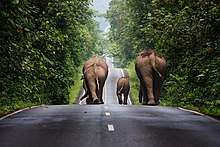 A herd of elephants walking up a road in the Park area
A herd of elephants walking up a road in the Park area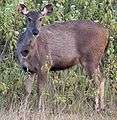 Female Sambar deer
Female Sambar deer A male Sambar deer
A male Sambar deer A fresh water crocodile
A fresh water crocodile
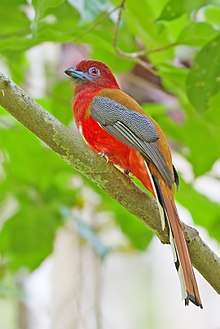
 Northern pig-tailed macaque (Macaca leonina)
Northern pig-tailed macaque (Macaca leonina)

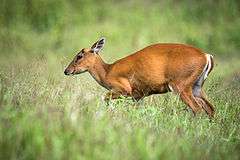


 Orange-headed thrush (Geokichla citrina)
Orange-headed thrush (Geokichla citrina)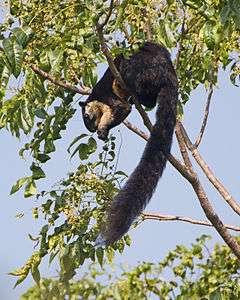
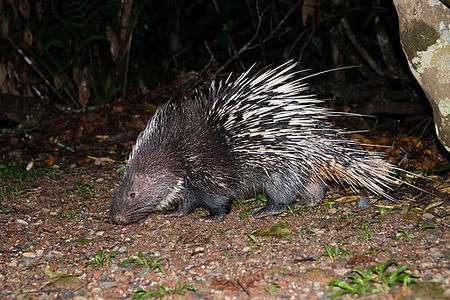 Malayan porcupine, Khao Yai National Park
Malayan porcupine, Khao Yai National Park_-_Khao_Yai_National_Park_01.jpg) A juvenile Trimeresurus vogeli (Vogel's Pit Viper)
A juvenile Trimeresurus vogeli (Vogel's Pit Viper)
Tribute
On September 18, 2017, Google celebrated the 55th anniversary of Khao Yai National Park with a Google Doodle.[6]
See also
| Wikimedia Commons has media related to Khao Yai National Park. |
- Dong Phayayen - Khao Yai Forest Complex
- Sankamphaeng Range
References
- "Bonanza Khao Yai resort faces demolition for encroachment of Khao Yai national park". Thai PBS. 8 April 2015. Archived from the original on 30 March 2017. Retrieved 30 March 2017.
- Panusittikorn, Pakkawadee; Prato, Tony. "Conservation of Protected Areas in Thailand: The Case of Khao Yai National Park" (PDF). George Wright Society. Retrieved 30 March 2017.
- "Give wildlife right of way" (Editorial). Bangkok Post. 5 January 2018. Retrieved 5 January 2018.
- Wangkiat, Paritta (5 March 2017). "Tourism pressures could be changing bear behaviour". Bangkok Post. Retrieved 30 March 2017.
- "18 tigers caught by surveillance cameras in world heritage site". Thai PBS. 28 March 2017. Retrieved 30 March 2017.
- "55th Anniversary of Khao Yai National Park". Google. 18 September 2017.
